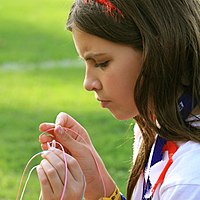
Photo from wikipedia
Macular pigmentation has been previously related to benefits for behavioral and neuroelectric aspects of selective attention across the lifespan. The relationship between accumulation of carotenoids beyond the central nervous system… Click to show full abstract
Macular pigmentation has been previously related to benefits for behavioral and neuroelectric aspects of selective attention across the lifespan. The relationship between accumulation of carotenoids beyond the central nervous system and selective attention is less understood, particularly amongst children. Therefore, this study aimed to assess the differential impacts of retinal and skin carotenoid accumulation and behavioral and neuroelectric indices of selective attention. Children between 7–12 years (N = 60) participated in the study. Macular pigment optical density (MPOD) was assessed using heterochromatic flicker photometry and skin carotenoids were assessed using reflection spectroscopy at the fingertip using the Veggie meter. Body Mass Index adjusted for age and sex (BMI%) and general intelligence as assessed using the Woodcock Johnson IV test were used as covariates. Behavioral performance (accuracy and reaction time) and neuroelectric indices (event-related brain potentials [ERPs]) of attentional inhibition were assessed during a modified Eriksen Flanker task. Specifically, amplitude of the P3 waveform was used to index attentional resource allocation. After controlling for covariates, MPOD was selectively associated with lower peak amplitude of the P3 waveform during congruent (β = −0.36, P = 0.01) and incongruent task trials (β = −0.39, P < 0.01). No significant relationships were observed between the P3 and skin carotenoids. Skin carotenoids were associated with higher accuracy on the incongruent trials of the Flanker task (β = 0.36, P = 0.02), while no relationships were observed between MPOD and behavioral performance. In this study, we were able to replicate previous findings demonstrating that higher accumulation of retinal carotenoids is associated with neural efficiency during a selective attention task. Skin carotenoids were associated with behavioral performance but were not related to neuroelectric indices of selective attention, suggesting site-specific benefits of carotenoid accumulation on cognitive health in childhood. This work is funded by the Egg Nutrition Center.
Journal Title: Current Developments in Nutrition
Year Published: 2020
Link to full text (if available)
Share on Social Media: Sign Up to like & get
recommendations!